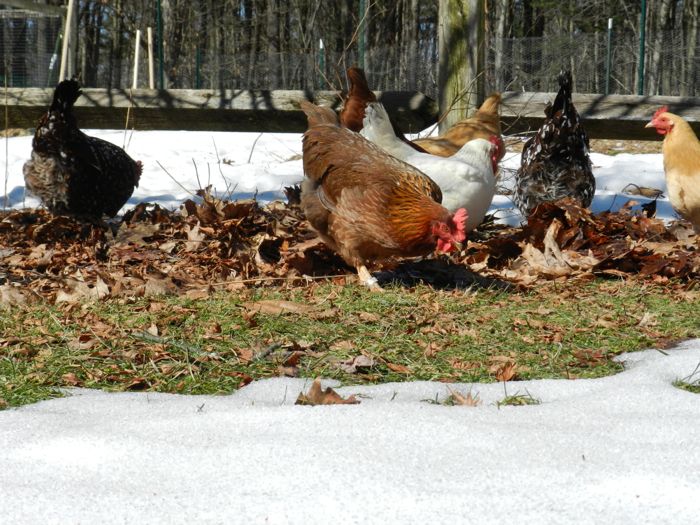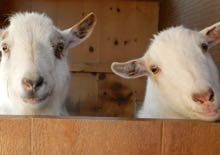Heads up: This post talks graphically about disease. I’ve heard from several people who have had their hens die due to this syndrome, and I think that it is a service to be blunt.
Chickens are so much fun to feed. Unlike certain finicky eaters at our own tables (spoken as the mom of the pickiest eater on earth) hens look delighted by the simplest food, whether a squishy tomato or a bit of stale bread. It’s so enjoyable to feed our hens that we sometimes overdo it, and feed the wrong foods to excess. Just as overeating causes health issues in people, so too does an unbalanced and high-calorie diet cause problems in your flock.
Hens are designed to eat small amounts constantly throughout the day. Eating should take effort, Your hens should be scratching, foraging, and pecking for their dinner. But, most backyard flocks are confined, and so they don’t roam for their food. Add to that indulgent owners that love seeing their hens happily chortling at grain tossed at their feet. Chickens are getting fat, and they’re not just waddling around in discomfort, they’re dying from obesity.
A diet too high in corn and other scratch feeds lays on the fat. A layer of internal fat can physically get in the way of egg laying. The hen needs to have a smooth passage of that egg through the reproductive tract. Fat impedes it, and can even block the egg laying process.
But, yellow fat in the body cavity, and laying difficulty, isn’t the worst that can happen to your hen. The next step in disease is Fatty Liver Syndrome. This is also called Fatty Liver Hemorrhagic Disease, which reflects what happens inside of your hen. The fat marbles the liver and changes it’s texture. The fat infiltrates the ovaries. The hen’s organs can no longer function properly. Sadly, despite being fat, they begin to starve. The change in the texture of the liver makes the hen susceptible to lesions and hemorrhaging. The release of an egg from the ovary can tip the balance. Blood vessels will rupture. Your hen will bleed to death.
The right diet is the key to preventing this disease. I’ve written about a prudent diet here. Keeping your hens physically active and eating throughout the day is also essential. One thing that keeps my hens busy, even in limited space, is the compost in the chicken run. Of course, if you can let your hens out to forage, that helps, too. Exercise, fresh air, sunshine and a prudent diet high in vegetables – sounds like something all of us, whether hens or their keepers, should try to live by.
For more details on this disease the Mississippi State University Extension Service has a clear explanation. The Merck Vet site is also a good resource.
BTW, feeding excess protein, such as handfuls of mealworms, causes other severe health issues, especially kidney disease. I’ve written about that here.


Well said. I was guilty of putting out too many treats and lost a hen to Fatty Liver Disease and have another one who have it. The vet gave her medicine to help jump start her liver and I know how you feel about vet visit for chickens. But she’s very special to me. And it worked. Her old personality came back and she’s much more active and the fatty lump under her has gone down in size.
I learned my lesson and I’m much more careful now with what they get as a treat and how much.
I’m not against vets like yours that are actually knowledgeable and effective!
How can one tell if their hens are too fat? I have some heavily feathered chickens and it’s difficult to tell if they are fat or fluffy!
It’s difficult. It helps to know the breed standard. It helps to handle your hens, so that you’ll feel a difference if they put on weight. But, really, it’s hard! The best thing is to feed them properly and then you won’t have to worry.
my lovely avian vet told me that you should always be able to feel the breastbone (or ‘keel’) and not be too concerned about it feeling too ‘sharp’ as hens that spend all day galloping about outdoors put all their muscle and bulk on their legs, which is something I can sympathise with…. he has seen hens where he couldn’t feel the breastbone for fat!
How would a newbie know what too much is. I will have 7 Pullets in mid-May and want to get of to a good start.
You don’t need to feed any scratch grains, but if you do, I’d limit it to less than a tablespoon per bird per day.
I rescued a hen a few months ago I thought it would make a good friend for my other chicken. She was fat and crazy, she also had all of her wing an tail feathers missing. She has laid no eggs, but she gets to free range a lot and has lost a lot of weight, at first I thought I was starving her somehow but she has access to 16% pellets 24/7. She seems ok just skinny, she doesn’t act crazy any more, makes me wonder what she must have gone thru before I got her. I was wondering if she could make my young hens sick in some way when it comes time for them to live together?
Thankyou for that, I wondered if I was giving too much corn and thankfully I’m not.
I have been wondering how much scratch was too much for my Hens. You are so right about how easy it is to fall in the trap of over-feeding as it is so enjoyable watching the chickens gobbling it all up. So my girls will get a rude awakening when they look expectantly at me for their usual ration this evening. But hopefully I will now get to enjoy their company for a little longer. Once again, thanks!
I love your blog. I don’t have chickens but love yours and love the goats too. I read that you live west of Boston and wonder if you are near West Boxford? Have a good friend there. Keep blogging and I’ll keep reading.
We’re within driving distance, but not neighbors.
K I will admit I’m guilty I do give my hen a lil scratch daily I guess I will have to cut it back but was wondering how good are layer pellets for them? I buy the Purina Brand in a 11.33Kg bag.
Guilty! Ive known it but they are so darn cute. I give them an ear of corn every afternoon to split between six hens. Is this ok? I was giving a handfu of scratch in the morning but im gonna stop that. They do get either a head of cabbage or some kale everyday but thats until they can forage for fresh again. I dont give them mealworms but a couple times a week a raw hamburg meatball, they go crazy over it. Just figured they cant get bugs etc. now
Corn on the cob makes them work a bit, and one ear for your six hens isn’t too much. The meatball is fine, too. Sounds like you’re not overdoing it.
Ok thank you I feel better now. I trust your judgement more than any of my books.
It is so satisfying, giving the girls treats. I so appreciate your giving an actual suggested maximum amount. I sprout whole grains (a mix of oats, hard and soft wheat, rye, barley etc., whatever I can find between Whole Foods and the feed store) about 2/3 cup pre sprouting, for 7hens each morning. I have read that after the third day of sprouting, the grains go from being more carbs to more protein. Since my girls don’t get to free range much, I figure this way they get a treat that has live plant nutrition, along with the ‘treat’ factor.
Believe it or not, my hens don’t go crazy for corn. I do feed our 12 about a cup of scratch consisting of wild bird seed every morning. It’s mostly millet with some sorghum and small amounts of corn and black oil sunflower seeds. They go for the millet first (they love it!) and pass over the corn and sunflower seeds until everything else is gone.
I had read somewhere (sorry, can’t remember the citation but it might have been one of Joel Salatin’s books) that having some whole seeds their diet is good because it’s less processed than chicken feed and provides some extra fiber. Have you read that anywhere in your research of poultry diets?
Also…I haven’t seen Buffy on camera lately. I hope she’s doing ok.
Keeping my hens trim is tricky as they seem to have a passion for digestive biscuits as you can see! http://www.thechickenwhisperer.co.uk/2013/03/book-signing.html